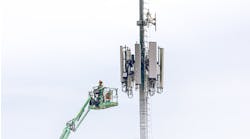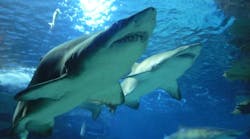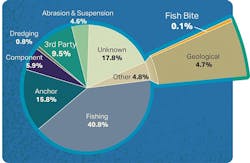Latest from Installation & Maintenance
A “Low-Fiber” Diet for Sharks
Setting the Record Straight on Shark Attacks
Some actors are just born to play villains. Who can forget the late, and sadly missed, Alan Rickman and his portrayal of Hans Gruber in Die Hard, or the Sheriff of Nottingham in Robin Hood: Prince of Thieves (Christmas is cancelled!)?
In the world of marine biology, the ultimate villain has to be the shark—a beast so psychotic that it must keep moving at all times or it will die. But are sharks as dangerous as movies and TV would have us believe—at least when it comes to subsea cable damage?
Despite their appearance in films such as Jaws, Jaws 2, Jaws 3-D, and so on, not to mention The Meg franchise, most sharks are completely harmless—especially when it comes to their undeserved reputation for damaging submarine cables.
Like any good urban myth, there is a smattering of truth at play…the magnetic fields emitted by underwater cables of all types attract those “evil” sharks, potentially causing them to bite into cables and creating a world of problems for the service providers who are sending vital traffic over them. Given the importance of submarine cables, this is a serious outcome. Let me quickly remind you of the vital role of submarine cables before I step in to defend the humble and much maligned shark.
The Pivotal Role of Submarine Cables
There are over 550 submarine cables under the seas and oceans of the planet—with 480 in operation and a further 70 under construction. In my experience, people who are not “in the business” of telecommunications are often unaware that over 99% of intercontinental traffic passes over these cables and not via satellites. They carry updates from our Facebook friends, our Google searches, and over $10 trillion in financial transactions every day. So, to call them “pivotal” is no exaggeration.
What Can Cause a Subsea Cable Outage?
Submarine cable outages, while not exactly common, are not exactly rare either. According to reports by the International Cable Protection Committee (ICPC), there are between 100 and 200 incidents of damage to cables around the world each year, but on average only four of those involve deep water sections of the cable—which would be the most expensive and time-consuming to repair. All the others occur in shallow water—but how many of them are caused by sharks?
Figure 1 shows a breakdown of cable faults for all types of submarine cable from 1901 to 2020. As you can see, well over two-thirds of cable outages are man-made in some way. There’s a big “unknown” category, and I’ll talk more about that later, because maybe it’s sharks and we just can’t be sure, right?
Confirmed fish bites represent around 0.1% of incidents between 1901 and 2020.
Given this span of time, let’s go back to that theory of magnetic attraction. In the telegraphic cable era between 1901 and 1957, at least 28 cables were damaged by fish bites attributed mainly to sharks, as determined from teeth found embedded in cable sheathings, as well as other fish such as barracuda.
Given that the mode of data transmission over this period was over copper conductors, it’s not unreasonable to go along with the magnetic field theory. And given the obvious signs of fish attacks in these cases, we can probably assume that none of the “unknown” category would include our fin-flapping friends.
Between 1959 and 2006, 11 cable repairs were recorded as being caused by fish bites. This period covers the deployment of coaxial submarine cables, which would still generate magnetic fields, as well as the early fiber optic cables that were deployed in the 1980s.
Given the change to optical fiber, do we think these cables generate magnetic fields? In fact, they do because long-distance fiber optic cables will include repeater modules every 60 to 100 km along the cable, and these repeaters have to be electrically powered. The cables include a conductor layer that carries a very high DC voltage to power the amplifiers, and even though it’s DC, the operation of the repeater as it works to amplify a set of modulated data signals will cause the magnetic field to “wobble,” which might well attract various types of fish.
Do Sharks Attack Fiber Optic Cables?
To cut to the chase—yes. But only because of a design fault in the earliest repeatered cables that has subsequently been fixed. The first subsea repeatered fiber optic system, AT&T’s SL Undersea Lightwave System, was deployed in 1985 on the OPTICAN-1 route between Gran Canaria and Tenerife, and it used a lightweight, 21-mm cable type with no armoring.
This cable failed on four occasions because of shark attacks in water depths of up to 1,900 m, and at this time, OPTICAN-1 accounted for <0.5% of global submarine cable faults. Dozens of shark teeth were recovered from the failed sections of cable, and so the cause of failure was pretty conclusive—those pesky sharks!
You might be picturing the shark from Jaws literally biting through the cable, but that’s not what happens. The shark doesn’t need to actually cut through the fiber—the dental penetration just needs to be enough to slice into the polyethylene insulator layer and cause the power conductor to short out to the sea. This is called a shunt failure and is the most common failure mode in subsea cables historically—although the root cause of the insulator damage is most likely to be anchors and nets rather than sharks.
The investigators noticed that there was an older coaxial cable, SAT-1, that followed the same route as OPTICAN-1. SAT-1 had been in service for 17 years without a single fish-related failure. So why was OPTICAN-1 attracting shark bites and not SAT-1? It couldn’t just be that SAT-1 was a coaxial cable because, between 1956 and 2006, there were 11 fish-related cable attacks, and seven of them were on other coaxial cables.
What did SAT-1 have that other cables did not? The answer seemed to be that SAT-1 included a metal tape layer just under the insulator, and while this was too thin to function as armor protection, it did seem to be functioning as a Faraday cage to prevent electromagnetic fields leaving the cable. Now that the cause of fish attacks in repeatered fiber cable had been identified, the design of subsequent cables was changed to include a shield layer.
Since 2006 there have been no recorded fish-related attacks on submarine fiber optic cables.
Cables Are Vulnerable to Humans, Not Sharks!
While sharks—and let us not forget other ninja fish like barracudas—are off the hook (sorry) we still have that issue of 100 to 200 cable failures per year. What causes them and what can we do about them?
Location, Location, Location
First, let’s be clear, subsea cables are marked on maritime maps and are protected under international treaties that forbid fishing and anchoring within a certain distance of the cable. Ideally, they are routed to avoid regions of seismic activity, although this is not always possible in highly active areas such as the seas off Portugal or pretty much all of Southeast Asia. In shallow waters, where they are most vulnerable to anchors and fishing nets, they are fabricated with massive steel armor, and, where possible, are buried several meters under the seabed using special plows.
Neighborhood Watch
There have been several attempts to implement monitoring technologies that are deployed on the ends of the cable. One of the most sensitive is distributed acoustic sensing (DAS), which is also used in terrestrial networks and can be combined with a rapid response team to identify unexpected construction work that might threaten a cable and to get to the right place to stop it.
A similar approach, subsea cables could detect anchors or fishing nets, and given the fact that all these vessels should have radar transponders to identify them, appropriate action could be taken. But DAS only works on the first 100 km or so of the cable and requires dedicated fiber, which is expensive in a long-distance cable.
More recently, a technique pioneered by Infinera, based on interferometric optical time-domain refractometry, which is being developed as a seismic detector for existing subsea cables, may be able to deliver the kind of sensitivity that could give a warning—but this requires real-world validation.
Let’s Make it Hug-a-Shark Week (Only Kidding)
It’s clear that sharks biting into subsea cables is a thing of the distant past, with zero shark-related incidents since cable designs were improved in 2006. Cables are certainly vulnerable to human activity, though, and there are parts of the world’s oceans where cable routes are getting quite congested.
Ultimately, operators themselves are reducing the worst of the problems by sharing capacity on their cables with other operators in a quid pro quo resilience approach. So, if one cable experiences a fault, traffic can be rerouted over an alternative route. This is not always possible, as we saw with the Tonga incident several months ago, which was caused by a subsea earthquake and made worse because there is only one cable into that island nation. Moreover, resilience must be built into submarine line-terminating equipment and extended to terrestrial backhaul networks, and this capability varies by vendor.
Geoff Bennett | Director of Solutions & Technology, Infinera
Geoff Bennett is the Director of Solutions & Technology for Infinera. He has over 25 years of experience in the data communications industry, including IP routing with Proteon and Wellfleet; ATM and MPLS experience with FORE Systems; and optical transmission and switching experience with Marconi, where he held the position of Distinguished Engineer in the CTO Office. Geoff is a frequent conference speaker and is the author of “Designing TCP/IP Internetworks,” published by VNR. For more information, visit https://www.infinera.com/. Follow them on Twitter, LinkedIn, and Facebook.





